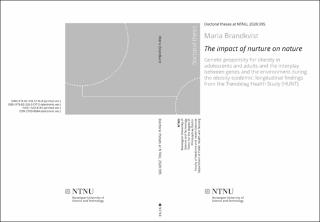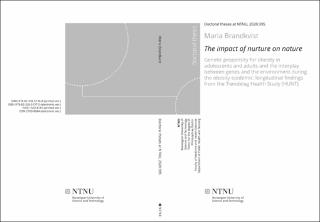| dc.contributor.advisor | Vie, Gunnhild Åberge | |
| dc.contributor.advisor | Bjørngaard, Johan Håkon | |
| dc.contributor.advisor | Ødegård, Rønnaug Astri | |
| dc.contributor.author | Brandkvist, Maria | |
| dc.date.accessioned | 2020-11-19T10:19:40Z | |
| dc.date.available | 2020-11-19T10:19:40Z | |
| dc.date.issued | 2020 | |
| dc.identifier.isbn | 978-82-326-5137-5 | |
| dc.identifier.issn | 2703-8084 | |
| dc.identifier.uri | https://hdl.handle.net/11250/2688636 | |
| dc.description.abstract | Summary
Background
Obesity has tripled worldwide since 1975 as environments are becoming more obesogenic. (1-3) The obesity epidemic is largely attributed to over-nutrition and sedentary behavior, both related to sociodemographic characteristics. However, the underlying cause is likely a complex combination of globalization, industrialization, and other societal, economic, cultural, and political factors. Although secular trends can change the prevalence of obesity in an entire population simultaneously, (4) genetic differences could make some people more susceptible than others to an obesogenic environment. (5-8)
Aims
The aim of this thesis is to illustrate how population weight and obesity are modified by the interplay between genetic predisposition and the obesogenic environment over six decades and to examine the robustness of the findings using sibling design. Recently, a powerful polygenic risk score for childhood BMI was developed in an unprecedented attempt to separate childhood and adult obesity. We aim to validate the childhood polygenic risk score for BMI and identify at what age the cross-over in terms of strength of prediction from the early life to the adult score occurs.
Methods
We conducted three studies based on the participants from the HUNT Study (1984- 2019) linked to previous height and weight measurements in the tuberculosis screening program (1966-69). The first study was based on data from the first three waves of the HUNT Study while the second and third study were based on data from all four waves.
In the first study, we estimated age adjusted BMI growth trajectories for different birth cohorts in the total study sample. Then we use the genetic risk score to estimate the effect of genetic risk of obesity on BMI according to time of measurement and age.
In the second study, we applied the genome-wide polygenic score (GPS) to estimate the effect of genetic risk of obesity on height-adjusted BMI, obesity and severe obesity according to time of measurement, age, and sex. One consideration is that genetic variants are not necessarily distributed randomly in a population. (9) By comparing differentially exposed siblings, we could provide an efficient adjustment for all shared confounding factors between siblings, such as assortative mating, dynastic effects and population stratification. (10)
In the third study, we used summary statistics from the genome-wide association study in the UK Biobank to construct, validate and then compare the childhood and adult genetic scores for obesity using data from HUNT participants.
Results
Obesity increased in Norway starting between the mid-1980s and mid-1990s and, compared with older birth cohorts, those born after 1970 had a substantially higher BMI already in young adulthood. BMI differed substantially between the highest and lowest fifths of genetic susceptibility for all ages at each decade, and the difference increased gradually from the 1960s to the 2000s. Hence, we found statistical evidence for a gene by environment interaction during the obesity epidemic.
In the second study we translated our novel finding to obesity while still conceptualizing year of assessment as a broad indicator of the environment. We found an increasing genetic inequality in obesity and severe obesity in an obesogenic environment. Despite being a very heritable trait, our study illustrates that body weight is modifiable proportionate to the degree of the obesogenic exposure. Our findings show an interplay between genes and the environment that is robust to family-level confounding using sibling design.
In the third study, we validate the childhood and adult polygenic risk scores for BMI and identify 16 years as the critical age separating the genetics of childhood and adult obesity.
Conclusion
This thesis provides evidence that genetically predisposed people are at greater risk for higher BMI and that genetic predisposition interacts with the obesogenic environment resulting in higher BMI and prevalence of obesity, as observed between the mid-1980s and late-2010s. Our findings are robust to family-level confounding using sibling design. While obesity is a highly heritable trait, (11) we illustrate how it is still modifiable according to the degree of the obesogenic exposure. This thesis also supports that genetic factors driving BMI differ at young age and in adulthood. Validating the new polygenic risk score for childhood BMI, our findings confirm the childhood score as a better predictor of body weight before the mid to late teens. Whilst it may be possible to identify those most susceptible to environmental change, who thus have the most to gain from preventative measures, efforts to reverse the obesogenic environment will benefit all ages of the whole population and help resolve the obesity epidemic. | |
| dc.language.iso | eng | en_US |
| dc.publisher | NTNU | en_US |
| dc.relation.ispartofseries | Doctoral theses at NTNU;2020:395 | |
| dc.relation.haspart | Paper 1:
Brandkvist, Maria Charlotta; Bjørngaard, Johan Håkon; Ødegård, Rønnaug; Åsvold, Bjørn Olav; Sund, Erik; Vie, Gunnhild Åberge.
Quantifying the impact of genes on body mass index during the obesity epidemic: Longitudinal findings from the HUNT Study. BMJ. British Medical Journal 2019 ;Volum 366. s. 1-8
https://doi.org/10.1136/bmj.l4067
This is an Open Access article distributed in accordance with the Creative Commons Attribution Non Commercial (CC BY-NC 4.0) | |
| dc.relation.haspart | Paper 2:
Brandkvist M, Bjørngaard JH, Ødegård RA, Brumpton B, Smith GD, Åsvold
BO, Sund ER, Kvaløy K, Willer CJ, Vie GA. Genetic associations with temporal shifts
in obesity and severe obesity during the obesity epidemic in Norway: a longitudinal
population-based cohort (The HUNT Study) | |
| dc.relation.haspart | Paper 3:
Brandkvist M, Bjørngaard JH, Ødegård RA, Åsvold BO, Smith GD,
Brumpton B, Hveem K, Richardson T, Vie GA. Separating the genetics of childhood
and adult obesity: a validation study of genetic scores for body mass index in
adolescence and adulthood in the HUNT Study | |
| dc.title | The impact of nurture on nature: Genetic propensity for obesity in adolescents and adults and the interplay between genes and the environment during the obesity epidemic: longitudinal findings from the Trøndelag Health Study (HUNT) | en_US |
| dc.type | Doctoral thesis | en_US |
| dc.subject.nsi | VDP::Medical disciplines: 700 | en_US |

